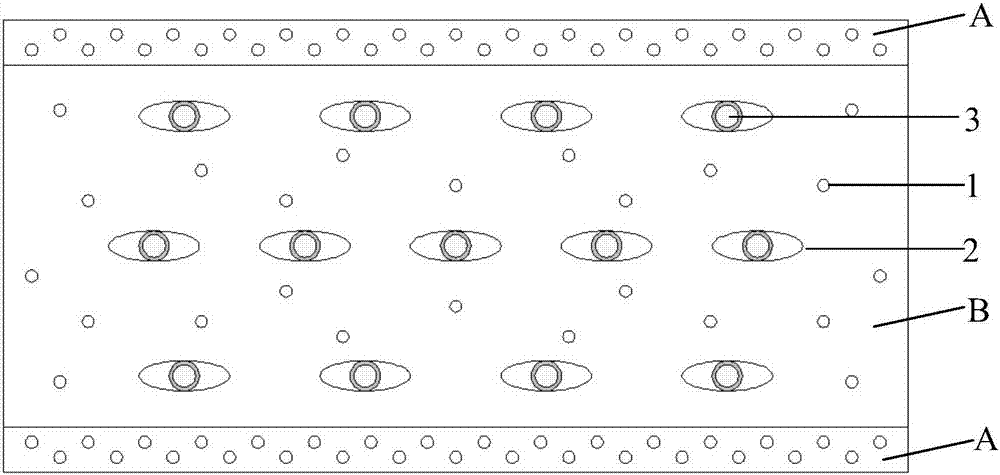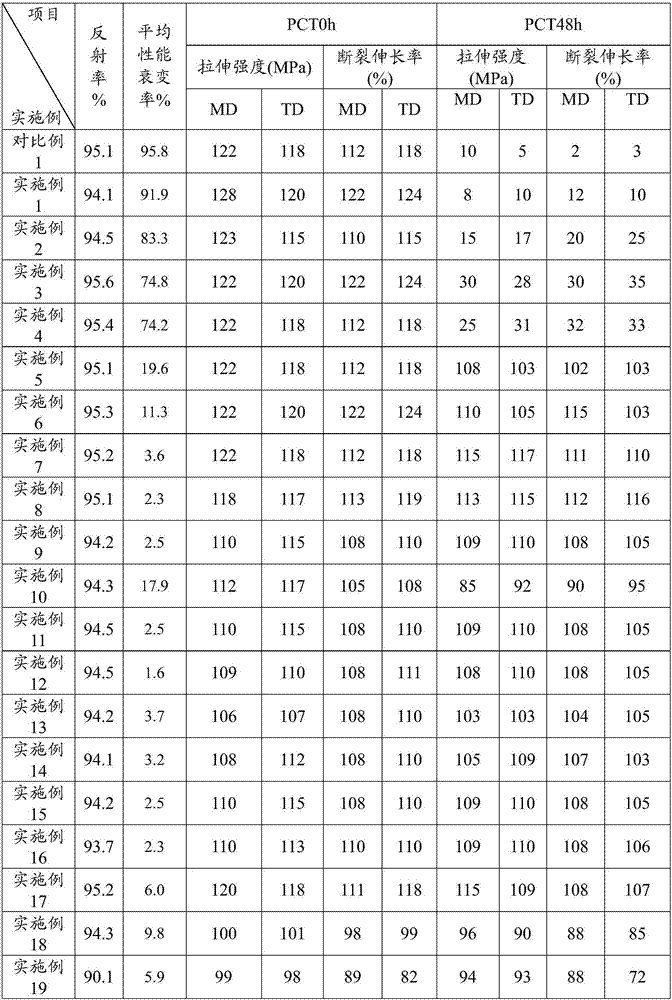Hydrolysis-resistant white reflective polyester thin film and preparation method thereof
A polyester film, white reflection technology, used in chemical instruments and methods, layered products, synthetic resin layered products, etc., can solve the problems of poor hydrolysis resistance of reflective films, and achieve a wide range of applications and good hydrolysis resistance. , good hydrolysis resistance
- Summary
- Abstract
- Description
- Claims
- Application Information
AI Technical Summary
Problems solved by technology
Method used
Image
Examples
Embodiment 1
[0067] In the hydrolysis-resistant white reflective film provided by the invention, the proportion of layer A is 89.5% of PET slices, 10% of silicon dioxide particles, and 0.5% of epoxy fatty acid glyceride. The proportion of layer B is 71% PET chips, intrinsic viscosity 0.68dL / g, 10% rutile titanium dioxide, 10% polymethylpentene, 5% MAH grafted SEBS (grafting rate ≥ 0.5%), 2% carbonization Diimine, 1% Millad3988 (Milliken Company), 1% PEG (molecular weight: 20,000), and the stated percentages are weight percentages. The thickness of layer A accounts for 12% of the total thickness, and the thickness of layer B accounts for 88% of the total thickness. The thickness of the obtained reflective film is 188 μm, and the relevant properties are shown in Table 1.
Embodiment 2
[0069] In the hydrolysis-resistant white reflective film provided by the invention, the proportion of layer A is 89.5% of PET slices, 10% of silicon dioxide particles, and 0.5% of epoxy fatty acid glyceride. The proportion of layer B is 66% PET chips, intrinsic viscosity 0.68dL / g, 10% rutile titanium dioxide, 15% polymethylpentene, 5% MAH grafted SEBS (grafting rate ≥ 0.5%), 2% carbonization Diimine, 1% Millad3988 (Milliken Company), 1% PEG (molecular weight: 20,000), and the stated percentages are weight percentages. The thickness of layer A accounts for 12% of the total thickness, and the thickness of layer B accounts for 88% of the total thickness. The thickness of the obtained reflective film is 188 μm, and the relevant properties are shown in Table 1.
Embodiment 3
[0071] In the hydrolysis-resistant white reflective film provided by the invention, the ratio of layer A is 89% of PET slices, 10% of silicon dioxide particles, and 1% of epoxy fatty acid glyceride. The proportion of layer B is 65.5% PET chips, intrinsic viscosity 0.68dL / g, 15% rutile titanium dioxide, 10% polymethylpentene, 5% MAH grafted SEBS (grafting rate ≥ 0.5%), 2% carbonization Diimine, 1.5% Millad3988 (Milliken Company), 1% PEG (molecular weight: 20,000), and the stated percentages are weight percentages. The thickness of layer A accounts for 12% of the total thickness, and the thickness of layer B accounts for 88% of the total thickness. The thickness of the obtained reflective film is 188 μm, and the relevant properties are shown in Table 1.
PUM
| Property | Measurement | Unit |
|---|---|---|
| thickness | aaaaa | aaaaa |
| thickness | aaaaa | aaaaa |
| thickness | aaaaa | aaaaa |
Abstract
Description
Claims
Application Information
 Login to View More
Login to View More - R&D
- Intellectual Property
- Life Sciences
- Materials
- Tech Scout
- Unparalleled Data Quality
- Higher Quality Content
- 60% Fewer Hallucinations
Browse by: Latest US Patents, China's latest patents, Technical Efficacy Thesaurus, Application Domain, Technology Topic, Popular Technical Reports.
© 2025 PatSnap. All rights reserved.Legal|Privacy policy|Modern Slavery Act Transparency Statement|Sitemap|About US| Contact US: help@patsnap.com



